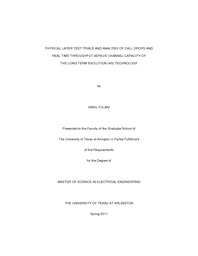
ATTENTION: The works hosted here are being migrated to a new repository that will consolidate resources, improve discoverability, and better show UTA's research impact on the global community. We will update authors as the migration progresses. Please see MavMatrix for more information.
Show simple item record
| dc.contributor.author | Fulani, Sanil | en_US |
| dc.date.accessioned | 2011-07-14T20:54:16Z | |
| dc.date.available | 2011-07-14T20:54:16Z | |
| dc.date.issued | 2011-07-14 | |
| dc.date.submitted | January 2011 | en_US |
| dc.identifier.other | DISS-11046 | en_US |
| dc.identifier.uri | http://hdl.handle.net/10106/5856 | |
| dc.description.abstract | Wireless communication has evolved rapidly in recent years and demand for mobile devices with new and higher services is increasing. The 3G standard, Universal Mobile Telecommunication System (UMTS) is already upgraded with High Speed Packet Access (HSPA) to meet current demands, but this is not sufficient considering the current needs of high speed services. Considering the demand for high speed service, 3rd Generation Partnership Project (3GPP) has come up with a technology called Long Term Evolution (LTE) technology called as 4G with an objective of a radio access technology with higher data rates, lower latencies and packet services such as multimedia and games to offer better quality. LTE is designed with a goal of evolving the radio access technology under the assumption that all services would be packet-switched, rather than following the circuit-switched model of earlier systems. Moreover, LTE is accompanied by an evolution of the non-radio aspects of the complete system, under the term 'System Architecture Evolution (SAE) which includes the Evolved Packet Core (EPC) network. Together, LTE and SAE comprise the Evolved Packed System (EPS), where both the core network and the radio access networks are fully packet-switched. This thesis mainly emphasizes on Physical layer and a proof for the physical layer message sequence. The main purpose of this master thesis is to study, analyze and implement a proof of Physical layer process in control plane of LTE system. The focus is on physical layer between the UE and eNB. Test trials were performed and screenshots for the analysis of call drops were taken and included. Results show the achievable Downlink and Uplink throughput in multi user and single user environment compared with the channel capacity of 10MHz channel. The thesis is mainly based on 3GPP LTE specifications and discussions. The methodology undertaken was divided into five parts. First, the studies part which was mainly based on 3GPP LTE specifications and real time work. Second, the testing part which was performed in a real scenario of LTE system deployed specifically for this test. Third, the analysis part, where the call setup procedure and physical layer message proof is implemented. Also, the call drops incurred during the test and its valid reason is analyzed. Fourth, the results part whereby the Average and Peak Achievable Downlink and Uplink Throughput for LTE is shown meeting the 4G requirements. Last part shows the conclusion that all the specifications mentioned by 3GPP is followed and proven that LTE is one of the best wireless communication technology of recent time. | en_US |
| dc.description.sponsorship | Liang, Qilian | en_US |
| dc.language.iso | en | en_US |
| dc.publisher | Electrical Engineering | en_US |
| dc.title | Physical Layer Test Trials And Analysis Of Call Drops And Real Time Throughput Versus Channel Capacity Of The Long Term Evolution (4G) Technology | en_US |
| dc.type | M.S. | en_US |
| dc.contributor.committeeChair | Liang, Qilian | en_US |
| dc.degree.department | Electrical Engineering | en_US |
| dc.degree.discipline | Electrical Engineering | en_US |
| dc.degree.grantor | University of Texas at Arlington | en_US |
| dc.degree.level | masters | en_US |
| dc.degree.name | M.S. | en_US |
Files in this item
- Name:
- Fulani_uta_2502M_11046.pdf
- Size:
- 3.912Mb
- Format:
- PDF
This item appears in the following Collection(s)
Show simple item record


